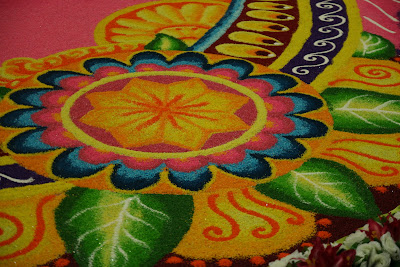Let's celebrate Deepavali~!!!! Diwali valthugal to every Tamil all around the world.
This year the Festival of Light (Deepavali) drop on 26th October 2011. You can see the decoration of kolam at almost every big shopping complex entrance. The 'kolam' is a symbol of an open heart and an auspicious welcoming.
Kolam (Tamil: கோலம் kõlaṁ) is a form of sandpainting that is drawn using rice powder by female members of the family in front of their home. It is widely practised by Hindus in South India. A Kolam is a geometrical line drawing composed of curved loops, drawn around a grid pattern of dots.
To define it in Malaysian way, the Malay word "kolam" describes it perfectly. It means "pool, pond or still water in a basin" in Malay language. The rice-painting-kolam is just like pool of still RICE in a basin, somehow forming a 3D visual effect : )
The practice of kolam were brought into Malaysia when the Indians came mainly as indentured labourers to work in the rubber plantation labour, traders, policemen and colonial soldiers from 1786 to 1824. Now Malaysian Indian will draw kolam on big celebration or festival like wedding and Deepavali.
There is an article that describe kolam appropriately. Auroville kolam
From Heart to Hearth
Each day before the sun rises, millions of women in south India say silent prayers as they sprinkle their hearths with rice powder or chalk to make kolams and invite the divine to grace their homes. The kolam -an ancient Dravidian geometrical motif - combines form, movement and colour to announce each new day. In Tamil, the word kolam implies beauty, form and play; it is a quiet ritual full of grace to make the home a sacred space.Women have drawn kolams before the entrances to their homes for centuries. Kolams may be linked to the earth, the stars or special festivities, but they are first and foremost a conscious offering to Mother Earth. They are prayers for prosperity, joy, wisdom, good health, and friendship. Their pretty patterns make villages and towns more festive, joyful, and devotional. Click here for more tradition kolam.
From Heart to Hearth
Each day before the sun rises, millions of women in south India say silent prayers as they sprinkle their hearths with rice powder or chalk to make kolams and invite the divine to grace their homes. The kolam -an ancient Dravidian geometrical motif - combines form, movement and colour to announce each new day. In Tamil, the word kolam implies beauty, form and play; it is a quiet ritual full of grace to make the home a sacred space.Women have drawn kolams before the entrances to their homes for centuries. Kolams may be linked to the earth, the stars or special festivities, but they are first and foremost a conscious offering to Mother Earth. They are prayers for prosperity, joy, wisdom, good health, and friendship. Their pretty patterns make villages and towns more festive, joyful, and devotional. Click here for more tradition kolam.
Until recent times, kolams were most often drawn with coarse rice flower, thus serving as a conscious offering to nature's creatures. Rice flower is seen as an offering to Lakshmi, the goddess of rice. In south India, where wealth is measured in terms of rice fields, Lakshmi plays an essential caretaker role to assure the family's continued existence and survival. The goddess has the power to attract wealth and prosperity and to prevent poverty from entering the home.
Today, especially where rice is expensive, kolams are made of powered limestone, red soil or chalk. In some regions salt, turmeric powder, flowers, rocks, stones and sawdust are also used. Some women cannot resist the more colourful store-bought artificial chalk power tints and the technicolour world of magentas, emerald greens, turquoise and cobalt blues. Plastic sticker kolams are also used and herald city life and a different set of priorities for a woman's time.
reference:



















No comments:
Post a Comment